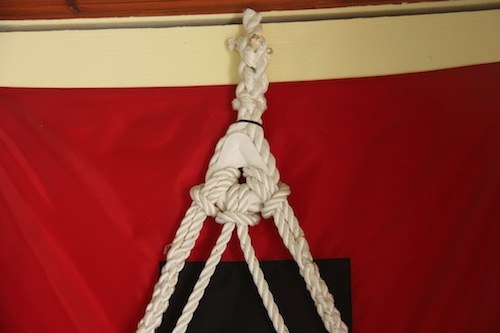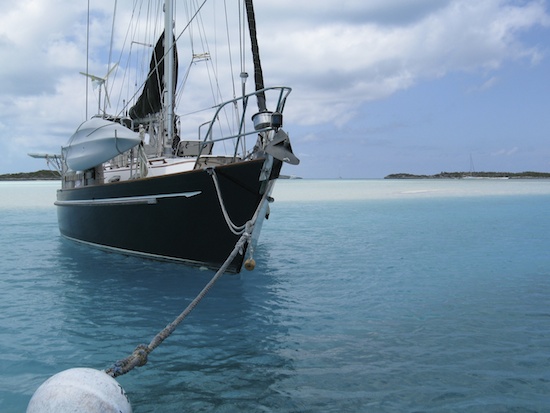Here at the Boot Key Harbor mooring field/City Marina, Marathon, Florida Keys, there’s a special flag to alert boaters when more preparation is necessary for an upcoming storm. On the wall at City Marina they have the flag and also an example of how they want the boat’s lines attached to the mooring.
We figure it’s worth knowing – we don’t frequent mooring fields as a rule, preferring to anchor (after all, who knows how secure the mooring is or when the last time it was inspected!). But we were caught once when chartering — Hurricane Mitch in 1998 turned around and headed back through the Keys and then Abacos/Bahamas as a tropical storm. We went into Hopetown, tied to a mooring ball and then the harbormaster helped us put down an extra anchor. Knowing this info on how to attach to a mooring for a storm certainly would have been useful information then too! (Note: we rode out the storm with no problem other being terrified … then there was that big power boat dragging down on us, but we survived and the charter boat survived.)
The recommended storm mooring includes one extra line and a different attachment strategy for the other two lines. Normally they just want you to run a line through the eye loop and back to the same side of the boat, then do another for the other side. Here they have a different attachment, and the example shows a line with a spliced loop in the end thats attached to the mooring pennant. I’m assuming if we had to do this, we’d simply run both lines back to the boat on the outside. But it could be done this way to eliminate chafe between the two exterior lines.
Here’s a closeup. You can see the three lines going through the thimble of the mooring. The center line then feeds back to a cleat on each side of the boat. The outside lines are attached as shown, then spliced and then fed back to the cleat on one side. So each cleat would end up with two lines.
So now we know what to do if a serious storm is headed toward somewhere we’re in a mooring field … and we’ll all hope that we never have to know this information! Do you have input or more information? Please leave a comment and share! Cheers! Jan
















Executing a spllce hanging over the bow on a bouncing mooring sounds like a challenge – though I think the picture has your standard mooring warps with soft eyes spliced in already, and attached with a simple cow hitch. Nice and quick and secure, could be a problem on departure if/ when the cow hitch binds tight onto the mooring hoop – impossible to release under load in any event!
My concern is that the mooring pennant is too thick to give the stretch which is so important to take up the shock loads, and the 3 short lines going to the cleats are too short to allow for good stretch, and not substantial enough. Length of line is important when using a hurricane mooring to avoid tearing out cleats, which I have seen happen,
Hi Phil! This is just the recommended mooring tie up from Marathon City Marina/Boot Key Harbor – a prominent mooring field in the Florida Keys where boats live year round. So far, knock on wood, we haven’t been on a mooring in a named storm and don’t have any intention of trying to break our record. 🙂 Cheers — Jan
Phil, I don’t think the lines to the cleats are meant to be that actual length, this is a “diagram ” of the parts but with the extra line length removed. I am sure the actual length of the lines as shown wouldn’t even work between two cleats on the bow of a dingy let alone a 40 ft boat. You are quite correct that in real life the six lines would be 20-30 ft long. The 3x redundancy is a good plan, just my two bits worth
The idea of 3 lines onto a single BIG thimble is sound, but not IMHO the use of cow hitches – which will be a bitch to release in even light breeze, after an hour or two, and possibly hazardous for your crew/you to affix, dangling off the bows.Those will probbaly need to be cut away if you need to depart in a hurry. Instead, follow the centuries-old ‘ordinary practice of seamen’ and use a full round turn on each line. Zero chafe at the Big thimble, and easily slipped sequentially when you need to go. Don’t forget you still need anti-chafe where each line comes aboard. I use lengths of remaindered layflat fire hose, with holes punched/cord attached to secure it in place, but you can buy expensive, plastic-packaged stuff in chandleries.